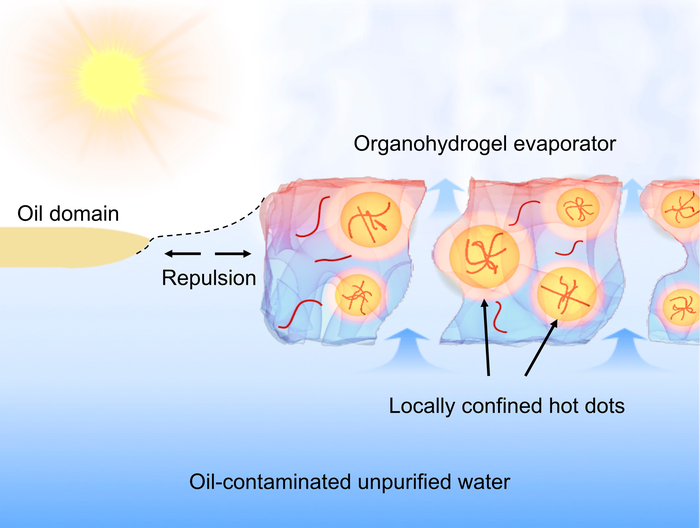According to the latest Intergovernmental Panel on Climate Change report from the United Nations, nearly 4 billion out of 7.8 billion people on Earth do not have access to adequate clean water for a minimum of one month per year, painting a dismal image for the world’s water supply.
 We propose an organogel-hydrogel compositing strategy for optimizing comprehensive performances of solar-driven evaporators in practical oil-polluted water purification. Ultra-stable floating ability, anti-oil-fouling property, accelerated vaporization process, long-term salt-resistance, and scalability are integrated at one platform. Image Credit: TSINGHUA UNIVERSITY PRESS.
We propose an organogel-hydrogel compositing strategy for optimizing comprehensive performances of solar-driven evaporators in practical oil-polluted water purification. Ultra-stable floating ability, anti-oil-fouling property, accelerated vaporization process, long-term salt-resistance, and scalability are integrated at one platform. Image Credit: TSINGHUA UNIVERSITY PRESS.
While a number of water purification systems have been suggested, they constantly fail at some important point—usually, they are not big, stable, or robust enough for practical applications, according to scientists from the Technical Institute of Physics and Chemistry, Chinese Academy of Sciences, and Xiamen University in China who may have solved the issue.
A new platform created by the team, reported in the March 22nd issue of Nano Research, uses sunlight to sanitize seawater with high energy efficiency compared to other similar methods (more than 90%) while also avoiding typical snags.
There is a tremendous demand for freshwater in households and for industrial, agricultural, and other applications, so various water purification technologies have been developed to alleviate the shortage of freshwater resources. Comparing the pathways, solar-driven purification of seawater or contaminated water via interfacial evaporation is promising as a low-cost system.
Miao Wang, Study Author, College of Materials, Xiamen University
These purification methods utilize sunlight to heat the surface of the water, thereby evaporating the water and dividing the salty or polluted counterparts from the water molecules, which then vaporize into the atmosphere to enter the innate cycle of condensation to turn into clean, consumable water.
According to study author Xu Hou from the College of Chemistry and Chemical Engineering, and College of Physical Science and Technology at Xiamen University, the issue is that attempts to expand this method for practical application have been delayed by salt-crystallization, instability, oil contamination, and complicated fabrication procedures.
To generate more purified water under the same amount of sunlight, how do we acquire more energy to locally heat water to improve the vaporization rate—without encountering the drawbacks of other approaches? We answered that question and designed an ultra-stable, salt-resistant evaporator platform that can maintain accelerated evaporation while also continuing to repulse oil to prevent contamination.
Xu Hou, Study Author, College of Chemistry and Chemical Engineering, and College of Physical Science and Technology, Xiamen University
Two gels were united in an oil-in-water emulsion by the scientists. The gel material, known as organohydrogel, can change between phases of matter but is mainly liquid held in a network of molecular chains.
By dosing the organohydrogel with carbon nanotubes, the scientists formed “hot spots” that can locally concentrate solar light to the water’s surface, stopping the dissipation of heat all over the area. The material’s branched structure also helps inhibit energy dissipation and boosts molecule transfer to stop salt crystallization.
The organohydrogel possesses a low density, so when soaking under the water surface level, it can self-float again for continuing the evaporation process. The raised water encompasses the evaporator, forming a lateral capillary repulsion effect wherein the oil molecules move away from the water being heated, akin to mercury moving away from the glass of a thermometer.
In the trial experiment, the system evaporated approximately 2.4 kg of water per square meter per hour and could continue for 240 hours without requiring additional disposal—even in circumstances of “tremendous oil contamination,” said study author Shutao Wang, Chinese Academy of Sciences (CAS) Key Laboratory of Bio-inspired Materials and Interfacial Science, Technical Institute of Physics and Chemistry.
We developed an anti-oil-fouling heating platform with remarkable solar energy utilization, which shows great potential for practical, solar-driven water purification even in heavily contaminated water. We hope that this economic and environmentally friendly approach will aid in further relieving the global scarcity of freshwater resources.
Miao Wang, Study Author, College of Materials, Xiamen University
The study included other contributors: Xuetao Xu, Haonan Li, Xizi Wan, and Yikai Zhang, CAS Key Laboratory of Bio-inspired Materials and Interfacial Science, Technical Institute of Physics and Chemistry; and Wen He and Shuli Wang, College of Chemistry and Chemical Engineering, Xiamen University. Xu, Li, Zhang, and Shutao Wang are also affiliated with the University of CAS.
This research was supported by the National Natural Science Foundation of China’s Projects of International Cooperation and Exchanges, the National Key Research and Development Program of China, and the National Program for Special Support of Eminent Professionals and the Fundamental Research Funds for Central Universities.
Journal Reference:
Xu, X., et al. (2022) Oil-polluted water purification via the carbon-nanotubes-doped organohydrogel platform. Nano Research. doi.org/10.1007/s12274-022-4118-8.